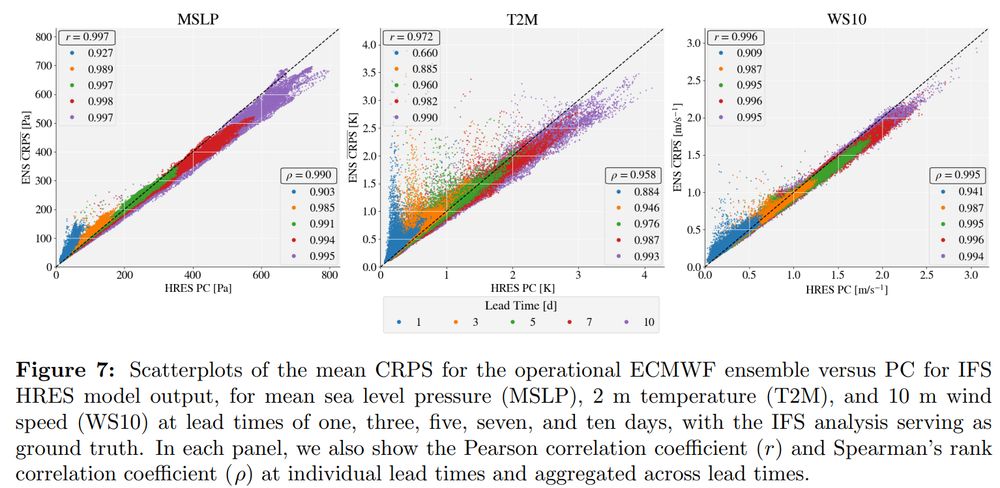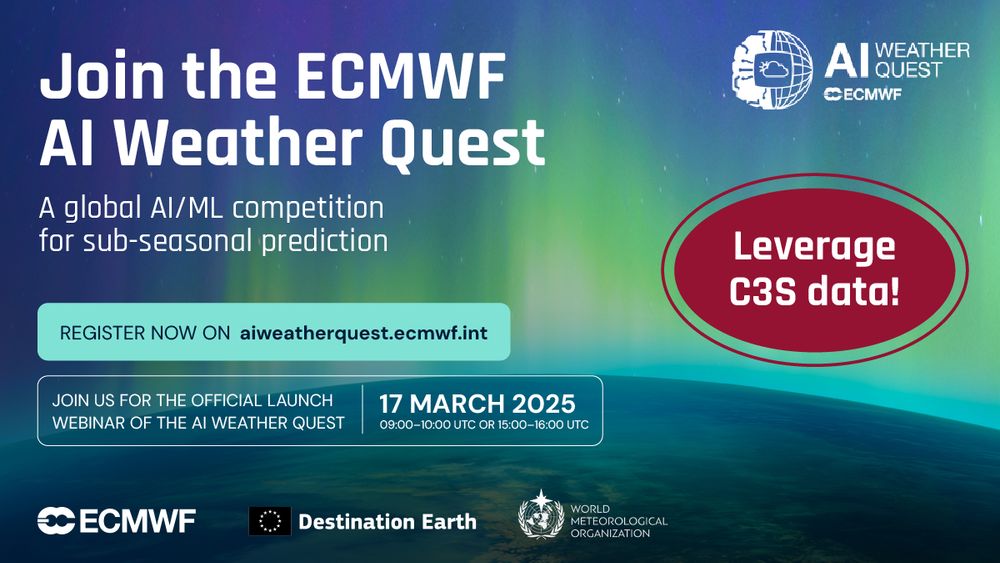Operational convection-permitting COSMO/ICON ensemble predictions at observation sites (CIENS)
The original data is available at dx.doi.org/10.35097/EOv.... We also provide code for matching forecasts and observations, and for an exemplary comparions of ML-based post-processing models.
07.08.2025 16:10 — 👍 0 🔁 0 💬 0 📌 0

Forecast are available for 55 meteorological variables mapped to station locations and spatially aggregated forecasts from surrounding grid points, for NWP models initialized at 00 and 12 UTC, in hourly lead times up to 21h. Observations of 6 variables are available at 170 stations.
07.08.2025 16:10 — 👍 0 🔁 0 💬 1 📌 0

The potential CRPS of the HRES forecast aligns well with the CRPS of the operational IFS ensemble.
05.06.2025 08:47 — 👍 0 🔁 0 💬 1 📌 0

AIWP models show skillful forecasts for lead times of up to 10 days when compared to the ERA5 climatology in terms of the potential CRPS.
05.06.2025 08:47 — 👍 0 🔁 0 💬 1 📌 0

Results on WeatherBench 2 data confirm fast-paced progress, with AIWP models, in particular GraphCast, showing improvements in the potential CRPS over the HRES model
05.06.2025 08:47 — 👍 0 🔁 0 💬 1 📌 0
Step 2: We then compute the CRPS on the test dataset. The resulting "potential CRPS" quantifies potential probabilistic predictive performance and serves as a proxy for the mean CRPS of real-time, operational
probabilistic products.
05.06.2025 08:47 — 👍 1 🔁 0 💬 1 📌 0
We propose a new measure for fair and meaningful comparisons of deterministic AIWP and NWP models:
Step 1: We subject the deterministic backbone of AIWP and NWP models post hoc to the same
postprocessing technique (isotonic distributional regression) on the test dataset.
05.06.2025 08:47 — 👍 1 🔁 0 💬 1 📌 0
There has been fast-paced progress in AI-based weather prediction. However, fair comparisons to physics-based NWP models are challenging:
- AI models are trained on the MSE, and might have an advantage in MSE-based comparison
- Comparisons may use different ground truth data (ERA5 vs IFS analysis)
05.06.2025 08:47 — 👍 1 🔁 0 💬 1 📌 0

In addition to forecast evaluation via proper scoring rules, we also evaluate the forecasts from an economic perspective by considering trading strategies that utilize the multivariate probabilistic information.
03.06.2025 05:37 — 👍 0 🔁 0 💬 0 📌 0

We propose a generative ML model for multivariate, probabilistic forecasting of time series of electricity prices, and compare to state-of-the-art statistical benchmark models.
03.06.2025 05:37 — 👍 2 🔁 0 💬 1 📌 0
Thanks!
25.03.2025 13:58 — 👍 0 🔁 0 💬 0 📌 0
Thanks!
25.03.2025 13:58 — 👍 0 🔁 0 💬 0 📌 0

Image: https://en.wikivoyage.org/wiki/File:Marburg_Oberstadt_von_SO.jpg
Personal update: After almost 10 years at KIT, I will move to the University of Marburg as a professor at the Department of Mathematics and Computer Science in April. I will of course miss the many great colleagues and students at KIT, but am very much looking forward to exciting new opportunities.
25.03.2025 09:02 — 👍 16 🔁 0 💬 3 📌 0

The AI Weather Quest is now open for participation! This @ecmwf.int led competition, endorsed by the @wmo-global.bsky.social, challenges participants to push the boundaries of sub-seasonal to seasonal forecasting using artificial intelligence (AI) and machine learning (ML).
🔗 bit.ly/4b1ulaB
18.02.2025 10:18 — 👍 21 🔁 6 💬 0 📌 0

New preprint: "Learning low-dimensional representations of ensemble forecast fields using autoencoder-based methods" with Jieyu Chen and Kevin Höhlein: arxiv.org/abs/2502.04409. We propose dimensionality reduction methods tailored to ensemble simulations of gridded fields.
10.02.2025 08:02 — 👍 7 🔁 0 💬 0 📌 0
Improving Model Chain Approaches for Probabilistic Solar Energy Forecasting through Post-processing and Machine Learning
All details and links to all datasets are available in the paper (rdcu.be/d462L). Code is available at github.com/HoratN/pp-mo....
02.01.2025 20:26 — 👍 1 🔁 0 💬 0 📌 0

We further compare the post-processing approaches to a NN-based direct forecasting model, which predicts PV power based on the weather inputs without the intermediate conversion via the model chain, and achieves almost the same performance.
02.01.2025 20:26 — 👍 1 🔁 0 💬 1 📌 0

Applying post-processing to the PV power predictions obtained as the output of the model chain is the most important contributor to improving the forecasts, whereas the effects of post-processing the weather inputs are negligible.
02.01.2025 20:26 — 👍 0 🔁 0 💬 1 📌 0

In a case study on a benchmark dataset from the Jacumba solar plant in the US, we find that post-processing generally improves the GHI and PV power forecasts. Neural network-based methods achieve slightly better performance than statistical approaches.
02.01.2025 20:26 — 👍 1 🔁 0 💬 1 📌 0

We investigate the use of post-processing and ML in model chain approaches, where different strategies are possible: Post-processing only the weather inputs, post-processing only the PV power predictions, or applying post-processing in both steps (or none at all).
02.01.2025 20:26 — 👍 0 🔁 0 💬 1 📌 0
Probabilistic PV power forecasts are often based on model chain approaches, where conversion models estimate PV generation based on weather predictions. However, weather prediction models make systematic errors and require post-processing.
02.01.2025 20:26 — 👍 0 🔁 0 💬 1 📌 0
Our new paper "Improving Model Chain Approaches for Probabilistic Solar Energy Forecasting through Post-processing and Machine Learning" (with Nina Horat and Sina Klerings) just appeared in Advances in Atmospheric Sciences, rdcu.be/d462L 🌤️🔌
02.01.2025 20:26 — 👍 2 🔁 0 💬 1 📌 0

In a case study on a benchmark dataset from the Jacumba solar plant in the US, we find that post-processing generally improves the GHI and PV power forecasts. Neural network-based methods achieve slightly better performance than statistical approaches.
02.01.2025 20:21 — 👍 0 🔁 0 💬 0 📌 0

We investigate the use of post-processing and ML in model chain approaches, where different strategies are possible: Post-processing only the weather inputs, post-processing only the PV power predictions, or applying post-processing in both steps (or none at all).
02.01.2025 20:21 — 👍 0 🔁 0 💬 1 📌 0
Probabilistic PV power forecasts are often based on model chain approaches, where conversion models estimate PV generation based on weather predictions. However, weather prediction models make systematic errors and require post-processing.
02.01.2025 20:21 — 👍 0 🔁 0 💬 1 📌 0
KI-HopE-De Postdoc Position.pdf
bwSync&Share
I will be at the CMStatistics conference in London from Saturday to Monday, let me know if you'd like to meet, e.g. to talk about the available postdoc position (bwsyncandshare.kit.edu/s/HXJrexofCa...)
12.12.2024 08:28 — 👍 1 🔁 1 💬 0 📌 0
HEPEX is a global collective of researchers and practitioners advancing ensemble prediction in hydrology
https://hepex.org.au
Researcher at FU Berlin •Nature's 10 2024 •Creator of RW #Hijackedjournals checker •Scientific misconduct •Plagiarism • #papermills •Corruption in higher education
PhD Student in Psychological Methods (University of Marburg)
Interested in time series, simulation studies & open science
https://bsiepe.github.io
Professor of Psychological Methods @Phillips-Universtät Marburg
Mathematical psychology | Cognitive modeling | Psychometrics | Bayesian statistics
Personal: www.dwheck.de
Team: https://www.uni-marburg.de/de/fb04/team-heck
ML / Geosciences. PI @ Helmholtz Centre Hereon.
Prof of Hydroclimatology & Associate Head of the Social Sciences Division (Research & Impact), University of Oxford
I am an engineer, PhD, MSc working mainly on the intersection of geoscience and statistical modelling with a focus on machine learning algorithms, their combination with physics-based models and predictive uncertainty estimation.
Netzwerk der LOEWE-Forschungsvorhaben
LOEWE Research Initiatives Network
Blog: https://argmin.substack.com/
Webpage: https://people.eecs.berkeley.edu/~brecht/
Recently a principal scientist at Google DeepMind. Joining Anthropic. Most (in)famous for inventing diffusion models. AI + physics + neuroscience + dynamical systems.
Economic forecasting, statistics, housing markets, survey data, ML, expectations formation.
Check out my webpage:
https://sites.google.com/site/mhartmann69121/
#ecologista #meteorologo #deputato #granconsiglio #ticino #locarno #ciclista
www.teobuz.ch
Meteorologist and Head of Innovation Science with The Weather Company. I work on deep learning applied to probabilistic weather prediction. In my free time, I hike, bike, read, pick up dog poo, and chip the bark off trees (disc golf).
Professor at @vub_etro @VUBrussel and researcher at KMI-IRM @meteobenl - WATS Ambassador for Brussels - Voorzitter Fietsersbond Halle - FOSS enthusiast
🌧️🚴🏾♀️⛅🚶🏾♀️☀️👩🏾💻🎷🧗🏾♀️
Wir sind die Philipps-Universität Marburg und noch neu hier. Wir schauen uns erstmal nur um.
Computer Vision and Earth observation to support environmental sciences.
Asst. Prof. at University of Copenhagen & Pioneer Centre for AI
formerly: PhD at ETH Zürich
#CV #ML #EO #AI4EO #SSL4EO #ML4good
🔗 langnico.github.io
Geoscience/Machine Learning. Scientist working on improving Earth system models with the help of deep learning. CEREA, école nationale des ponts et chaussées. 🇫🇷🇩🇪
Associate Professor of Computational Chemistry, University of Birmingham
https://www.grynova-ccc.org/
views my own
We aim at unraveling the intricacies of molecular perception and designing sensing molecular systems from the ground up. We work at the interface of biophysics, biochemistry, and materials science.
@ Max Planck Institute for Polymer Research, Mainz.














